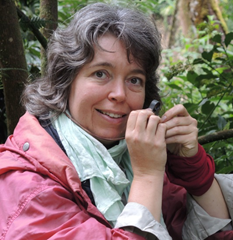Prof. Dr. Meike Piepenbring, University of Frankfurt am Main, Germany

About Prof. Dr. Meike Piepenbring. Mycologist at the University of Frankfurt am Main, Germany, Lecturer in Mycology and Botany since 2002. From 2008 till 2009 she worked as a guest professor at Universidad Autónoma de Chiriquí, Panama (DAAD long-term scholarship). Head of a mycology research group with a focus on taxonomy, morphology, and systematics of plant parasitic microfungi, tropical mycology, and fungal diversity. She guided many research and teaching activities in Latin America (Panama, Costa Rica, Ecuador, Bolivia) and Benin.
Topic of the plenary talk: What do we know about fungal diversity in West Africa? Results from a checklist compilation
Authors: Meike Piepenbring, José G. Maciá-Vicente, Nourou Soulemane Yorou
Abstract of the talkMore than 10,000 records of species of fungi and fungus-like organisms were found in more than 800 publications and are compiled in the first checklist of fungi in West Africa. They represent more than 4,000 fungal species known for West Africa. These species are cited in the checklist together with information on their systematic position, ecology, host species, references to literature, and occurrence in West African countries. Relatively high species numbers are obtained for Ghana, Ivory Coast, Nigeria, and Sierra Leone, while for Gambia, Guinea-Bissau, Mali, and Niger only few species of fungi are known.Mycological investigation in West Africa started at the end of the 18th century with European naturalists who travelled to West Africa. They were followed by mycologists, lichenologists, and phytopathologists from Europe, who carried out most mycological studies until the second half of the 20th century. Since 1950, African mycologists started to become increasingly numerous and productive. We estimate that the species diversity presented in the checklist corresponds only to a small part of the fungal diversity present in West Africa. The incompleteness of the data is particularly evident by the fact that species accumulation curves to estimate the rates of species discovery are far from reaching saturation, and by the fact that a high number of the fungal species reported are cited only once in the literature. We are still in a pioneer phase of exploration of African fungal diversity!
Key words: History of mycology in West Africa; pioneer phase of exploration; species accumulation curves; taxonomy
